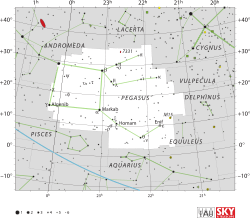Mu Pegasi

| |
| Observation data Epoch J2000.0 Equinox J2000.0 | |
|---|---|
| Constellation | Pegasus |
| Right ascension | 22h 50m 00.19315s[1] |
| Declination | +24° 36′ 05.6984″[1] |
| Apparent magnitude (V) | 3.514[2] |
| Characteristics | |
| Spectral type | G8 III[3] |
| U−B color index | +0.674[2] |
| B−V color index | +0.932[2] |
| Astrometry | |
| Radial velocity (Rv) | +13.54 ± 0.20[4] km/s |
| Proper motion (μ) | RA: +144.70[1] mas/yr Dec.: –41.87[1] mas/yr |
| Parallax (π) | 30.74 ± 0.27[1] mas |
| Distance | 106.1 ± 0.9 ly (32.5 ± 0.3 pc) |
| Absolute magnitude (MV) | 0.432[5] |
| Details | |
| Mass | 1.3[6] M☉ |
| Radius | 9.6 ± 0.4[7] R☉ |
| Surface gravity (log g) | 2.50[3] cgs |
| Temperature | 4,950[3] K |
| Metallicity [Fe/H] | –0.03[3] dex |
| Rotational velocity (v sin i) | 4.0[8] km/s |
| Other designations | |
Mu Pegasi (μ Pegasi, abbreviated Mu Peg, μ Peg), also named Sadalbari,[10] is a star in the northern constellation of Pegasus. The apparent visual magnitude of this star is 3.5,[2] which is bright enough to be seen with the naked eye even on a moonlit night. The distance to this star can be determined with parallax measurements, which yields a value of 106.1 light-years (32.5 parsecs) from the Sun.[1]
Nomenclature
μ Pegasi (Latinised to Mu Pegasi) is the star's Bayer designation.
It bore the traditional name Sadalbari, which derives from the Arabic term for "luck star of the splendid one".[11] In 2016, the International Astronomical Union organized a Working Group on Star Names (WGSN)[12] to catalogue and standardize proper names for stars. The WGSN approved the name Sadalbari for this star on 21 August 2016 and it is now so entered in the IAU Catalog of Star Names.[10]
Properties
The spectrum of this star matches a stellar classification of G8 III.[3] The luminosity class of 'III' means that it has exhausted the hydrogen fuel at its core and evolved into a giant star. It is slightly more massive than the Sun, but has expanded to nearly ten times the Sun's radius.[7] (Mishenina et al. (2006) list it with an estimated 2.7 times the mass of the Sun.[5]) The effective temperature of the outer atmosphere is about 4,950 K,[3] which is cooler than the Sun and gives it the yellow hue of a G-type star.[13][14] The abundance of elements other than hydrogen and helium, what astronomers term the metallicity, is similar to the abundance in the Sun.[3]
References
- 1 2 3 4 5 6 van Leeuwen, F. (November 2007), "Validation of the new Hipparcos reduction", Astronomy and Astrophysics, 474 (2): 653–664, arXiv:0708.1752
 , Bibcode:2007A&A...474..653V, doi:10.1051/0004-6361:20078357
, Bibcode:2007A&A...474..653V, doi:10.1051/0004-6361:20078357 - 1 2 3 4 Jennens, P. A.; Helfer, H. L. (September 1975), "A new photometric metal abundance and luminosity calibration for field G and K giants.", Monthly Notices of the Royal Astronomical Society, 172: 667–679, Bibcode:1975MNRAS.172..667J, doi:10.1093/mnras/172.3.667
- 1 2 3 4 5 6 7 Frasca, A.; et al. (December 2009), "REM near-IR and optical photometric monitoring of pre-main sequence stars in Orion. Rotation periods and starspot parameters", Astronomy and Astrophysics, 508 (3): 1313–1330, Bibcode:2009A&A...508.1313F, doi:10.1051/0004-6361/200913327
- ↑ Famaey, B.; et al. (January 2005), "Local kinematics of K and M giants from CORAVEL/Hipparcos/Tycho-2 data. Revisiting the concept of superclusters", Astronomy and Astrophysics, 430 (1): 165–186, arXiv:astro-ph/0409579
 , Bibcode:2005A&A...430..165F, doi:10.1051/0004-6361:20041272
, Bibcode:2005A&A...430..165F, doi:10.1051/0004-6361:20041272 - 1 2 Mishenina, T. V.; et al. (September 2006), "Elemental abundances in the atmosphere of clump giants", Astronomy and Astrophysics, 456 (3): 1109–1120, arXiv:astro-ph/0605615
 , Bibcode:2006A&A...456.1109M, doi:10.1051/0004-6361:20065141
, Bibcode:2006A&A...456.1109M, doi:10.1051/0004-6361:20065141 - ↑ Smith, G. (November 1998), "Stellar atmospheric parameters for the giant stars MU Pegasi and lambda Pegasi", Astronomy and Astrophysics, 339: 531–536, Bibcode:1998A&A...339..531S
- 1 2 Nordgren, Tyler E.; et al. (December 1999), "Stellar Angular Diameters of Late-Type Giants and Supergiants Measured with the Navy Prototype Optical Interferometer", The Astronomical Journal, 118 (6): 3032–3038, Bibcode:1999AJ....118.3032N, doi:10.1086/301114
- ↑ Massarotti, Alessandro; et al. (January 2008), "Rotational and Radial Velocities for a Sample of 761 HIPPARCOS Giants and the Role of Binarity", The Astronomical Journal, 135 (1): 209–231, Bibcode:2008AJ....135..209M, doi:10.1088/0004-6256/135/1/209
- ↑ "48 Peg -- High proper-motion Star", SIMBAD, Centre de Données astronomiques de Strasbourg, retrieved 2012-01-28
- 1 2 "IAU Catalog of Star Names". Retrieved 28 July 2016.
- ↑ Allen, Richard Hinckley, (1963) [1899]. Star Names: Their Lore and Meaning (rep. ed.). New York, NY: Dover Publications Inc. pp. 328–29. ISBN 0-486-21079-0.
- ↑ IAU Working Group on Star Names (WGSN), International Astronomical Union, retrieved 22 May 2016.
- ↑ "The Colour of Stars", Australia Telescope, Outreach and Education, Commonwealth Scientific and Industrial Research Organisation, December 21, 2004, retrieved 2012-01-16
- ↑ Kaler, James B., "SADALBARI (Lambda and Mu Pegasi)", Stars, University of Illinois, retrieved 2012-01-28